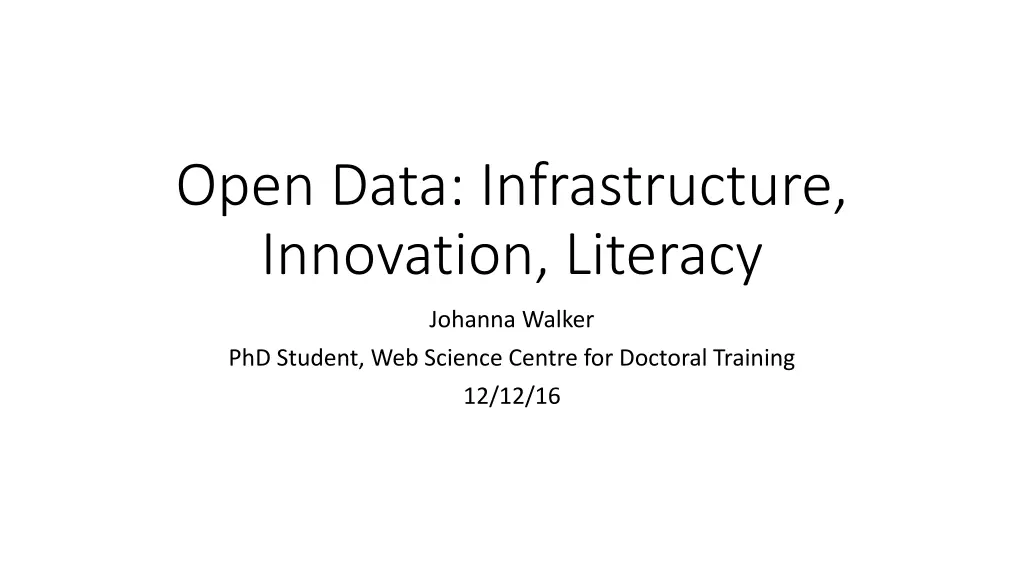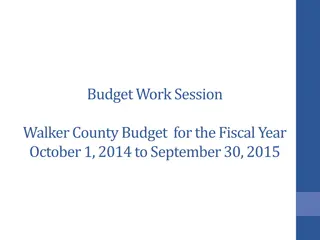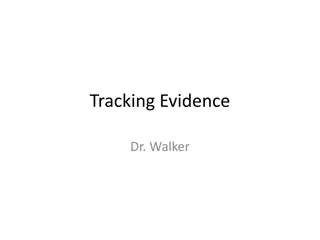
Understanding Open Data Infrastructure and Innovation
Explore the significance of open data infrastructure through the lens of innovation and literacy, emphasizing principles of open availability, reuse, and universal participation. Delve into topics such as data management, government data accessibility, and the National Information Infrastructure framework to enhance your understanding of this dynamic field.
Download Presentation

Please find below an Image/Link to download the presentation.
The content on the website is provided AS IS for your information and personal use only. It may not be sold, licensed, or shared on other websites without obtaining consent from the author. If you encounter any issues during the download, it is possible that the publisher has removed the file from their server.
You are allowed to download the files provided on this website for personal or commercial use, subject to the condition that they are used lawfully. All files are the property of their respective owners.
The content on the website is provided AS IS for your information and personal use only. It may not be sold, licensed, or shared on other websites without obtaining consent from the author.
E N D
Presentation Transcript
Open Data: Infrastructure, Innovation, Literacy Johanna Walker PhD Student, Web Science Centre for Doctoral Training 12/12/16
OKF: Three principles of open Availability and Access: that people can get the data (Infrastructure) Re-use and Redistribution: that people can reuse and share the data (Innovation) Universal Participation: that anyone can use the data (Data Literacy)
1. Data Infrastructure Our data infrastructure is a core part of our national infrastructure. From lists of legally constituted companies to the country s geospatial data, our data infrastructure needs to be managed, maintained, in some cases built and in all cases made as widely available as possible. Availability and Access: that people can get the data
National Information Infrastructure The NII is a management framework for the most strategically important data held by government. It is composed of: a set of guiding principles a curated list of the most strategically important data a governance structure baseline quality criteria (Coalition Government) https://www.gov.uk/government/uploads/system/uploads/attachment _data/file/416472/National_Infrastructure_Implementation.pdf
National Information Infrastructure (ODUG) Linked data is vital for (re)useability Unique identifiers Tools and products for (re)using data need to be co-located with datasets Raw data and versioned data should be provided Can support commercial data eg belonging to transport companies From Public Sector Information Catalogue to Productive Data: Defining a National Information Infrastructure Walker, J, Taylor J and Carr, L (2015) Fighting Phantom Firms in the UK: From Opening Up Datasets to Reshaping Data Infrastructures? Gray, J and Davies, T (2015)
Data quality issues for infrastructure Cleanliness of data is valued above all This may reduce usefulness; privilege certain datasets over others This may reinforce status quo and reduce creation of socially useful products, especially in niche or minority functions This may reduce the creation of knowledge Hackathons, data and discourse: Convolutions of the data (logical) Thornham, H and G mez Cruz, E (2016) Big Data and Society
2. Data Innovation If we are to make best use of data, we need a bridge between academic research, public, private and third sectors, and a thriving start-up ecosystem where new ideas and approaches can grow. Re-use and Redistribution: that people can reuse and share the data
$3tn Data: User Innovation and Open Data Exploring the potential for entrepreneurial innovation of open data products and services
Benefits of Open Data Transparency Accountability Participation Efficiency Social Value Research Value Economic Value
McKinsey (2013) Increased Efficiency New Products and Services Consumer Surplus
Open Data Innovation Lack of systematic measurement via impact metrics Little understanding of how innovation occurs through Open Data activities A recent study by NESTA suggested there was in fact surprisingly little innovation taking place utilising Open Data GovLab s stories of new economic impact focus on impact from a publication rather than an entrepreneurial point of view ODINE OpenData.Innovation: an international journey to discover innovative uses of open government data Rubenstein M, Cowls, J and Cath, (2016) NESTA
Literature Review Open Data Mechanisms for Data Release From Publishing to Usage Sources of Conflict Participation in Open Data Value Chain Data Literacy Demand Stimulus
Literature Review: User Innovation Agency Cost Reduction Lack of Incentives Lead Users Benefits of Learning Free Revealing Heterogeneity of Need User Innovation Communities
Literature Review: Open Source Communities Describes successful communities of innovation Identifies innovation in practice Creates framework
Research Questions RQ1: What kind of innovation is occurring in these communities? RQ2: How are these user innovation communities creating demand for open data? RQ3: Still working on that .
3. Data Literacy In order to take advantage of the data revolution, policymakers, businesses and citizens need to understand how to make use of data. In other words, they must become data literate. Universal Participation: that anyone can use the data
Data Literacy State of the Art https://www.youtube.com/watch?v=7BTkylI60DM&feature=player_e mbedded c 2.20 talking about Data Literacy Journal of Community Informatics Special Issue on Data Literacy ci-journal.net
Emerging Research The DataWalk Engaging citizens with their data creation, consumption and implications Rural reaction to SmartCities and urban domination of data Three key questions: What are you collecting Why are you collecting it How/how often are you collecting it
Some arising issues Better understanding of what constitutes data: I thought data was all zeros and ones Codeification of local knowledge into data Much data identified is collected, and it is an issue of dissemination and awareness Geospatial data is dominant How is data delivered in rural communities at point and time of use
If youre interested in Open Data. General Open Data Handbook Open Data Charter Open Data Barometer Open Data Index Open Data 500 W3 Open Data McKinsey Report Research and Practical Activities Web Foundation IDDC International Open Data Conference Proceedings Open Data Research Symposium http://odimpact.org/resources.html Zotero Reading Group (development) http://odimpact.org/ Ebook Global impact of open data UK OGD Open Data White Paper Shakespeare Report theodi.org






















